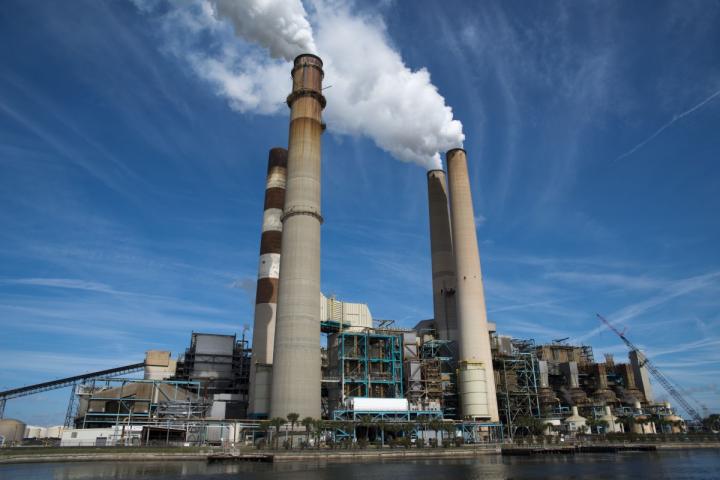Warmer, lower rivers from climate change might leave some US power plants high and dry

Credit: Creative Commons
DURHAM, N.C. — Older power plants with once-through cooling systems generate about a third of all U.S. electricity, but their future generating capacity will be undercut by droughts and rising water temperatures linked to climate change. These impacts would be exacerbated by environmental regulations that limit water use.
The solution is not to scrap the regulations, a new Duke University study shows. It’s to scrap the old cooling systems.
“If we want to have reliable electricity and, at the same time, protect the lakes and rivers that provide cooling water to the plants, we need to retrofit the plants with recirculating cooling systems,” said Lincoln F. Pratson, Gendell Family Professor of Energy and the Environment at Duke’s Nicholas School of the Environment.
The new study shows that if surface waters warm 3 degrees Centigrade and river flows drop 20 percent — both of which are probable by the end of the century — drought-related impacts will account for about 20 percent of all capacity reductions at thermoelectric power plants with once-through, or open-loop, cooling systems. These reductions include capacity curtailments or shutdowns that could occur when local surface water levels drop at a plant’s intake structures.
Environmental regulations that govern a plant’s water use and the maximum temperature of used cooling water it can discharge back into rivers or lakes will account for much of the remaining 80 percent of future shutdowns and capacity cuts, Pratson said.
“It’s surprising that the impacts of drought will be so much larger than those of warmer temperatures, which we estimate will account for little more than 2 percent of reductions,” said Candise L. Henry, a 2018 PhD graduate of Duke’s Nicholas School, who led the study as part of her doctoral dissertation. “But it’s also surprising that drought impacts will be so much smaller than regulatory impacts.”
“Fortunately, nearly all of these impacts could be mitigated by switching to recirculating cooling systems,” Henry said.
Thermoelectric power plants use steam-driven turbines to generate their energy. Once the steam has passed through the turbines it must be cooled down. Once-through systems do this by drawing in cold water from nearby rivers or lakes, circulating it through pipes to absorb the steam’s heat, and discharging the heated water back into the river or lake.
In recirculating systems, water from a cooling tower is used to absorb the steam’s heat and then routed back to the tower where the heat is released through evaporation. Plants with this type of system don’t discharge heated water to surface waters and only have to replace the portion of their cooling water supply that is lost through evaporation, making them less vulnerable to drought impacts and environmental regulations.
“Right now, it’s fairly common for plants to be granted provisional exemptions from rules governing the maximum allowable temperature of discharged water, but if regulations become more stringent under future administrations, we could see more curtailments or shutdowns of once-through power plants,” said Henry, who is now a postdoctoral researcher at the Carnegie Institution for Science at Stanford University.
She and Pratson published their peer-reviewed findings March 8 in Environmental Science & Technology.
To conduct their study, they analyzed seven years of operational and meteorological data for 52 eastern U.S. power plants with once-through cooling systems. Using an electricity generation model, they combed the data — which spanned the years 2007 to 2014, when severe droughts affected much of the Southeast — to track how hourly changes in local water temperatures and flow rates affected each plant’s maximum power output.
By running the model under seven different water-availability and temperature scenarios, they were able to tease apart what percentage of the total changes in generating capacity was caused by rising water temperatures, what portion stemmed from decreased water flow, and how much was linked to regulatory compliance. Using projected warming and water flow trends for the coming century, they estimated the likely future impacts of each factor.
“Past studies bundled the impacts of drought, water temperatures and environmental regulation together,” Pratson noted. “By pulling them apart, we gain a much clearer picture of what the big threats will be and what we can do to mitigate them.”
The fact that drought impacts will be so much larger than those caused by warmer water underscores the need to prioritize mitigation strategies that focus on water flow, he said. In addition to installing recirculating cooling systems, these strategies include installing ponds to hold cooling water reserves; locating new plants on larger bodies of water; and implementing more stringent watershed management plans to regulate water use by all users located on a river or lake.
###
CITATION: “Differentiating the Effects of Climate Change-Induced Temperature and Streamflow Changes on the Vulnerability of Once-Through Thermoelectric Power Plants,” Candise L. Henry and Lincoln F. Pratson. Environmental Science & Technology, March 8, 2019. DOI: 10.1021/acs.est8b05718
Media Contact
Tim Lucas
[email protected]
Related Journal Article
http://dx.




